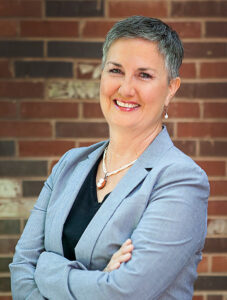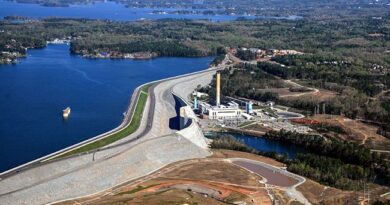The AI Interview: Marsia Geldert-Murphey, 2024 President, American Society of Civil Engineers
ASCE president discusses her new role, 2023 legislative wins and the need for sustainable and resilient infrastructure
 American Infrastructure: What are you looking forward to in your role as the 2024 Society President for the American Society of Civil Engineers (ASCE)?
American Infrastructure: What are you looking forward to in your role as the 2024 Society President for the American Society of Civil Engineers (ASCE)?
Marsia Geldert-Murphey: What I am looking forward to doing is creating and continuing to create a professional association that was relevant for me when I first started out, both as a student and as a young engineer. The reason that I am where I am today is because of my involvement with ASCE. I was a first generation college student. I did not have that legacy or that network already baked in. So ASCE really was this area where I learned who was out there, who to connect with, technical things that I needed to understand and what I needed for professional development. ASCE was that for me.
So what I’m going to focus on are all the amazing things that we already do. I’m not reinventing the wheel. We need to focus on our mentoring. With the great mentoring program that we have, I want to make sure that students and young engineers are mentored and are getting the support they need so that, not only will they become civil engineers, for those who are still considering it, but those who are our will stay with us. We always like to say, “we’ve got a leaking pipeline.” We get people in but sometimes they go to other professions.
Then also the diversity of our membership. I’m excited because for the first time in ASCE’s history, the ASCE Board of Direction is going to have more women than men. There’s going to be 11 women and eight men. We’re reflecting the population that we represent, which is really exciting.
I want to incorporate more of the next generation. I want them, our students and our younger members to really be engaged in shaping what ASCE looks like moving forward.
AI: Looking back on 2023, what are some United States infrastructure wins?
MGM: Two of the big legislative wins for us in 2023 are the PRECIP Act and the Floods act. PRECIP was a top legislative priority for ASCE. It will require NOAA to make some really significant changes in the way it collects data on maximum preset levels, and precipitation frequencies. If you think about it, we’re seeing that now. We’re seeing the frequency and we’re seeing the amount of precipitation changing from traditional patterns. Unfortunately, a lot of our standards and codes are based on historic data. That has to be updated. Under the PRECIP Act, NOAA is going to be required to work with the National Academies to produce a study that estimates precipitation. Then they’re gonna get a best practices together on creating that data moving forward. I cannot tell you how critical and how important that is, for every single one of us.
When you look at what happens with a lot of the infrastructure legislation, you can make arguments about which part of the population may potentially benefit more or less from that, but this one is an, “a high tide lifts all boats.” This is going to lift all of us to be safer. As engineers, we’re going to be able to make better design decisions. So the legislation is really essential to our engineering community. It’s going to give us more accurate data on rainfall and fluctuations.
Where we are investing in building our infrastructure now, we have to invest in it in a way where it will be around for a long time, and even while subjected to extreme events.”
Whether there’re still people who want to engage in the “whys” about climate change and arguing that, but as engineers, we have to concern ourselves with the “what now?” “What now do we do?” “How do we respond to this?” That is our focus. The fact of the matter is, the data is showing it is changing and we have to have up to date data, so that we can, not only design better for now, but we can predict the resilience of these systems for the future. That is really, really important, because if you think about it, we’re using old data, we’re already seeing that it’s not adequate enough for the conditions we’re seeing now. Then we’re still building to that criteria. It must be updated.
The FLOODS Act, basically, will require new measures to be implemented by NOAA to mitigate the effects of flooding, and other weather events like tornadoes and hurricanes as well. For example, the FLOODS Act requires NOAA to establish a National Integrated Flood Information System. What it’s going to provide is timely information and data to allow communities to better predict flooding events, and implement flood mitigation policies and practices.
If communities choose, with the floods act, they’re going to have this data available. So they can say, “well, this is what the code or standard says, but we know this is what we’re seeing now.” They can make educated wise decisions on their infrastructure, and also have a greater understanding of the differences that we’re seeing, and how important it is to stay up to date. We have to invest, in not only compiling this data, but really being rigorous about the data that we’re using for design
AI: Tell us about member engagement within ASCE.
MGM: Across the United States, we have what we call Advocacy Captains. In each state, and in our Commonwealth as well, we have a member who is considered the Advocacy Captain. They’re keeping their finger on the pulse of anything that’s going on with regards to legislation, or policies related to infrastructure. We have 177 policy statements regarding a variety of things, so our Advocacy Captains know that that’s where we, as a professional association, stand on any of those issues.
They mobilize our members in that geographic area and make them aware, “hey, reach out to your legislators. This is important to civil engineering and the civil engineering profession.” In addition, not only to the United States, but we have members in 177 countries. Some of our other countries are recognizing the benefits of the Americas Infrastructure Report Card. They are interested in preparing those report cards in other countries to help their legislators in moving forward on legislation and policy regarding infrastructure.
Additionally, we do our annual fly-in, which is not just a meeting with our representatives, it’s also educating and training our members on how to communicate with legislators and how to understand the policy statements that we have. In engineering, we understand the technical aspects that we have to know to be able to practice engineering proficiently with quality outcomes. We also understand that likewise, we have to make sure that we’re engaged on the public policy side too, because it really profoundly affects our profession.
When you think about it, a lot of it is our publicly built systems. We’re talking about water, wastewater, roads, bridges, inland waterways and levees. Those are typically driven by public or federal agencies. So we have to be engaged and understanding, and we do have a wonderful program within ASCE that educates our members and keeps them informed.
AI: What’s next for ASCE (new projects, initiatives, etc.)?
MGM: At our last board meeting, we approved a new standard ASCE 73, Standard Practice for Sustainable Infrastructure. This is the first standard I was most heavily involved in from the beginning, and it’s been several years to get it to where we are. It gives guidance on how infrastructure owners should address sustainability in their projects.
We’re seeing now that sustainability and resilience are more important than ever. Where we are investing in building our infrastructure now, we have to invest in it in a way where it will be around for a long time, and even while subjected to extreme events. That’s why ASCE 73 is so important.
We’re doing a few things at ASCE that we will continue to do in 2024. One is that we’re doing a road show with other stakeholders where we’re highlighting specific projects that have been funded and that are also helping the communities there.
We went to the Port of Long Beach, the Able Pump Station in Dallas, a converted station in Virginia, and we’ve got more on track for next year as well. We want to go all over the country. We want to show how these are helping the local communities. In addition to that, we’re also trying to get more people and kids excited about being civil engineers.
We have a program called Future World Vision. It takes a look at 50 years from now. What do we need? What are the trends that we are seeing in technology, in the styles of living, in the culture, in material changes, in climate change? How are we going to need to build and, and develop in the future and 50 years from now? What will those cities look like, whether it’s an urban area or a rural area?
We have a downloadable app, Future World Vision, that anybody, including nonmembers, can download from futureworldvision.org. The idea is to get young people engaged in looking at this and at some plausible scenarios for the future. You can engage with the program. You can say well, what about this? Did you think about that? It can be from anywhere in the world. One plausible scenario that we’re looking at in Future World Vision is called the mega city. Population is growing 80 million people a year right now. People are tending towards urban areas, because that’s where the jobs are, among other reasons. How are we going to properly function with these extremely large mega cities, and yet still sustain our environment? So we took that possible scenario and looked at some of the areas around the world that are already doing some things that we see could be scalable, on a greater scale moving forward, and are probably trends that we’ll be looking at.




